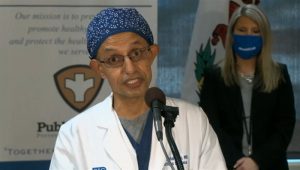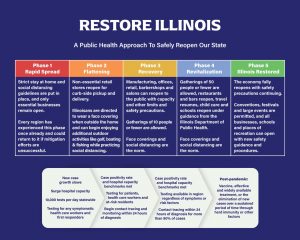Governor ‘very serious’ about enforcing guidelines as COVID-19 wave grows
By Jerry Nowicki Capitol News Illinois — October 22, 2020
Dr. Omer M. Badahman, an infectious disease specialist affiliated with multiple hospitals in the St. Clair County area, said at a news conference in St. Clair County Thursday, Oct. 22 the community must buy into the fight against COVID-19. (Blueroomstream.com)
SPRINGFIELD – Region 1 of the state’s COVID-19 mitigation plan will see a new tier of virus mitigations as Gov. J.B. Pritzker warned Thursday, Oct. 22 that “we are now headed into a peak that is beyond, potentially, where we were in March and April.”
“This pandemic is the greatest challenge that many of us have experienced in our lifetimes,” Pritzker said during a St. Clair County news conference on Oct. 22. “And when it comes to managing this pandemic, these mitigations are our best tools to find our way through to the other side.”
Region 1, which includes the northwest part of the state from Winnebago County to the western border, saw its positivity rate increase to 11.9 percent, according to the most recent data from the Illinois Department of Public Health. It has been over 8 percent for more than two weeks. The continued surge caused the state to implement even stricter mitigation guidelines than ones that have been in place since Oct. 3.
These will take effect Sunday, Oct. 25 and will include a decrease to the cap on social gatherings from 25 to 10 individuals and table caps at outdoor restaurants of six, rather than 10. The capacity guidelines apply to indoor and outdoor events and are applicable to professional, religious, cultural and social group gatherings, according to the governor’s office.
Indoor recreation activities must be capped at the lesser of 25 people or 25 percent of capacity, while group sizes for any activity must be smaller than 10. The rules do not apply to fitness centers.
The governor’s office noted this does not reduce the overall facility capacity dictated by general business guidance as it applies to office or retail space.
None of the region’s mitigations apply to schools or polling places, according to the governor’s office.
Pritzker said at the news conference that the state was “very serious and very focused” on enforcing added mitigations in any of the regions that currently have them.
“We are now seeing the entire state is moving up in terms of hospitalizations, in terms of ICU beds, ventilators, and death, not to mention the cases where they all begin,” he said, noting Illinois State Police will “not only issue warnings but also issue citations if necessary.”
“We are asking state’s attorneys to simply follow through on those citations, those are monetary citations,” he said. “We also … will look to remove people’s liquor license and their gaming license if they will not follow the resurgence mitigations.”
While Pritzker said he has been reluctant to revoke licenses, it would be an option as cases soar. He said it would not be up to him whether the revocation became permanent, but he noted “it is a long process to try to get it back.”
The mitigations are necessary at bars and restaurants because patrons often do not wear face coverings while eating and drinking, causing them to be one of the major places where the virus is spread, Pritzker said, citing contact tracing efforts. He also noted that private gatherings are a main driver of spread as well.
“These are actually the number one in spreading locations, and so we want to address as many of those as we can,” the governor said of private gatherings. “It’s up to you to address those at home; we’re doing what we can in the public sphere. We’ve got to get through this winter. …We are not even in winter yet, so please take this seriously.”
The announcement came as the state reported another one-day record for COVID-19 cases with 4,942 Thursday, Oct. 22, which trailed only Sept. 4, when the state reported 5,368 test results that included several days’ worth of tests due to data backlogs.
IDPH also announced an additional 44 virus-related deaths, pushing the death toll to 9,387 among 360,159 confirmed cases since the pandemic began. Tests completed surpassed 7 million on that Thursday.
Hospitalizations increased again as of Wednesday, Oct. 21, with 2,463 COVID-19-positive individuals hospitalized, an increase of 125, or 5.3 percent, from the day prior. COVID-19 intensive care bed usage jumped 4.5 percent from the day prior to 525, and ventilator usage jumped 9.2 percent to 212.
Dr. Omer Badahman, an infectious disease specialist affiliated with multiple hospitals in the St. Clair County area, said the community must buy into the fight against COVID-19 for it to be successful.
“If patients end up in our hospital, we’ve already lost half the fight,” he said. “So, the next step is to prevent this pandemic from spreading.”
He said the best ways to mitigate spread have long been known — wearing a face covering, washing hands, keeping six feet of distance from others when in public and not taking part in large gatherings. Illinoisans should also get their flu shot to limit stresses on the medial system, he added.
“The most important thing is masking,” he said. “There is no argument about whether masks work or not. Not anymore. Masks work to protect you, who’s wearing it, and they protect others. Wear it as much as you can. If you’re out there shopping, at work, picking up your kids from school, wear it as much as you can.”
As hospitalizations rise, the flu vaccine will be key to limiting over taxation on the health care system, Badahman said.
“This year it’s very important, because the health care system is taxed to the max,” he said. “We have bed shortages. We need those beds for other problems. So really, if we have influenza coming in with COVID-19, with the colder weather, the health care system is going to be overwhelmed. So I really want everybody to roll up their sleeves and get that influenza vaccine, even if you don’t believe in it.”
Regional positivity rates
The one-day statewide positivity rate was 5.7 percent as of Oct. 22, driven down by nearly 10,000 results reported on the University of Illinois campus which has a positivity rate below 1 percent. Each of the state’s 11 regions, which do not include the U of I tests, had a positivity rate of at least 7 percent.
Region 5 in southern Illinois, Region 7 in Will and Kankakee counties and Region 8 in DuPage and Kane counties, all of which, along with Region 1, are subject to increased mitigations from the state, remained above 9 percent as of the latest data from Oct. 19.
Any region above an 8-percent positivity rate for more than three days is subject to increased mitigations including the closure of bars and restaurants to indoor service. A region must fall below 6.5 percent for three days to have those mitigations lifted.
Region 4 in the Metro East increased to 7.8 percent, as did Region 9 in north suburban Lake and McHenry counties. Region 2, which includes Peoria and several surrounding counties, had a positivity rate of 7.1 percent.
Region 6 in east-central Illinois, which excluded the U of I tests, had a positivity rate of 7.5 percent for the second straight day, while Region 3, which includes Springfield and several surrounding counties, fell to 7.2 percent. Chicago and the Cook County suburbs, which make up Regions 11 and 10, respectively, remained flat at 7 and 7.2 percent.
jnowicki@capitolnewsillinois.com








